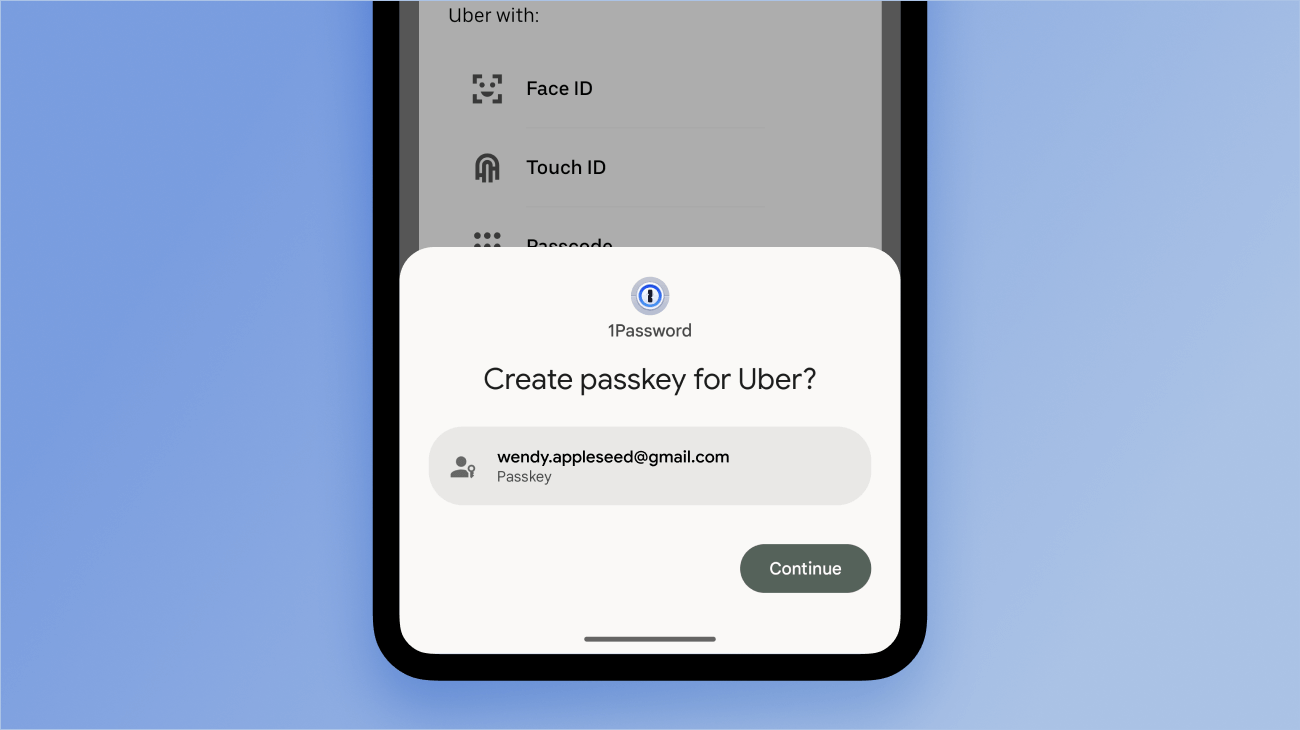Android enthusiasts, your time has come. If you own a phone or tablet running Android 14 or higher, you can now save and sign in to many Android apps using passkeys.
Today’s announcement builds on the passkey support we released for the desktop version of 1Password in the browser and 1Password for iOS last year. Mac, Windows, iOS, Android – no matter your platform preference, you can now go passwordless and start unlocking the web in a faster and more secure way.
We’re thrilled that so many people have started using passkeys, and are delighted that Android device owners can now embrace them too.
What is a passkey?
Passkeys are a new kind of login credential that lets you quickly and securely log in to accounts on your desktop and mobile devices. They’re a form of passwordless authentication – so there’s no password involved – that are backed by the largest technology companies and built on open industry standards.
Curious how passkeys work? Behind the scenes, the passwordless credential relies on public-key cryptography. That means every passkey consists of two parts: a private key and a public key. The private key is just that – private – and never shared with the service you’re signing in to. The other part is the public key, which is seen and stored by the website or app.
When you sign in with a passkey, the website or app creates a technical “challenge”, which is a bit like a special puzzle. You “sign” this challenge with your private key, which is then verified by the website or app using your public key. This quick back-and-forth relies on an API called WebAuthn, which was developed by the FIDO Alliance (1Password is a member of the Alliance!)
Passkeys vs. passwords
You can think of passkeys as the modern successor to passwords. Here are just a few ways that the two differ:
- Every passkey is strong by default. When you create a password, it’s possible to choose something weak like and re-use it across multiple accounts. Not so with passkeys. They’re always strong and can only be used for one website or app.
- Passkeys are phishing resistant. Passkeys can’t be phished like a traditional password because the underlying private key never leaves your device.
- Passkey can’t be stolen in a data breach. If one or more hackers breach a website or app, they might find some passwords. But if you secure your account with a passkey, the best the attacker can hope to find is your public key – which is useless without the associated private key.
Using passkeys with 1Password on Android: What you need to know
Here’s what you need to start saving and signing in to Android apps with passkeys:
- An Android device running Android 14 or higher.
- The latest version of 1Password for Android.
- An Android app that supports passkeys.
Remember: You can also use 1Password on any Android device to view, organize, share, and delete your saved passkeys.
1Password vs. Google’s passkey solution
You might be wondering: what’s the benefit of saving my passkeys in 1Password instead of Google Password Manager? It’s a great question.
Here are two reasons to choose 1Password:
1Password works everywhere. Google Password Manager is designed to work in three places only: Android, Chrome, and ChromeOS. 1Password, meanwhile, has thoughtfully-designed apps for every platform and supports every major web browser including Chrome, Firefox, Edge, Brave, and Safari.
1Password helps you organize your entire digital life. Google Password Manager is focused on passwords and passkeys. 1Password goes beyond a simple password manager by letting you store, manage, share, and conveniently autofill credit card numbers, addresses, documents, and all of your other sensitive information.
Start using passkey logins on Android
Creating a passkey for the first time couldn’t be more straightforward. First, open Watchtower (you’ll find it in the navigation bar at the bottom of 1Password for Android) to see which of your logins can be updated to use a passkey.
We recommend these three Android apps if you’ve never created or used a passkey login before:
- Amazon
- Uber
If it’s not already on your device, download the relevant Android app from the Google Play Store. Next, open the app and select the option to start using a passkey – it may be on the sign-in screen or in your account settings. Follow the instructions and, if prompted, choose to save your passkey in 1Password.

Once you’ve created and saved a passkey, you can use it every time you want to sign in to the associated account.
We’re delighted that so many Android developers have already updated their apps to support passkeys, and look forward to seeing the options grow in the coming months.
Passkeys are the future
We’ve said it before and we’ll say it again: we’re all in on passkeys, and believe they’re our ticket to a truly passwordless future. This type of login credential offers a faster and more secure way to sign in to online accounts. It’s supported by a growing number of websites and apps, as well as all of the major operating systems and password managers like 1Password.
If you want to be an early adopter and fully embrace this new era of online security, 1Password is the way to do it. For years, we’ve offered a safe home for your passwords, credit cards, medical records, and more. And we haven’t tied you down into any specific platform or ecosystem. Now you can add passkeys to the list of data that 1Password keeps secure at your fingertips.
Save and sign in to Android apps with passkeys
Ready to create some passkeys? Learn how to get started with 1Password for Android.
Start using passkeys on Android with 1Password
Save, manage, and securely share passkeys on your Android devices using 1Password for Android.

 by Travis Hogan on
by Travis Hogan on


